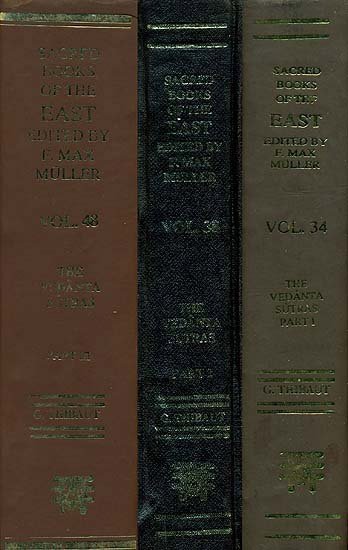Brahma Sutras (Ramanuja)
by George Thibaut | 1904 | 275,953 words | ISBN-10: 8120801350 | ISBN-13: 9788120801356
The English translation of the Brahma Sutras (also, Vedanta Sutras) with commentary by Ramanuja (known as the Sri Bhasya). The Brahmasutra expounds the essential philosophy of the Upanishads which, primarily revolving around the knowledge of Brahman and Atman, represents the foundation of Vedanta. Ramanjua’s interpretation of these sutras from a V...
Sutra 2.4.1
1. Thus the prāṇas.
After having taught that Ether and all the other elements are effects, and hence have originated, the Sūtras had shown that the individual soul, although likewise an effect, does not originate in the sense of undergoing a change of essential nature; and had in connexion therewith clearly set forth wherein the essential nature of the soul consists. They now proceed to elucidate the question as to the origination of the instruments of the individual soul, viz. the organs and the vital breath.
The point here to be decided is whether the organs are effects as the individual soul is an effect, or as ether and the other elements are. As the soul is, thus the prāṇas are, the Pūrvapakshin maintains. That means—as the soul is not produced, thus the organs also are not produced—For the latter point no less than the former is directly stated in Scripture; the wording of the Sūtra 'thus the prāṇas' being meant to extend to the case of the prāṇas also, the authority of Scripture to which recourse was had in the case of the soul.—But what is the scriptural text you mean?
'Non-being, truly this was in the beginning. Here they say, what was that? Those Ṛshis indeed were that Non-being, thus they say. And who were those Ṛshis? The prāṇas indeed were those Ṛshis.' This is the passage which declares that before the origination of the world the Ṛshis existed. As 'prāṇāḥ' is in the plural, we conclude that what is meant is the organs and the vital air. Nor can this text be interpreted to mean only that the prāṇas exist for a very long time(but are not uncreated); as we may interpret the texts declaring Vāyu and the atmosphere (antariksha) to be immortal: 'Vāyu and the atmosphere are immortal'; 'Vāyu is the deity that never sets' (Bṛ. Up. II, 3, 3; I, 5, 22). For the clause 'Non-being indeed was this in the beginning' declares that the prāṇas existed even at the time when the entire world was in the pralaya state. Those texts, then, which speak of an origination of the prāṇas must be explained somehow, just as we did with the texts referring to the origination of the individual soul.
To this the Siddhāntin replies, 'the prāṇas also originate in the same way as ether, and so on.'—Why?—Because we have scriptural texts directly stating that before creation everything was one, 'Being only this was in the beginning,' 'The Self only was this in the beginning.' And moreover, the text 'from that there is produced the prāṇa and the mind and all organs'(Mu. Up. II, 3, 1) declares that the organs originated; they therefore cannot have existed before creation. Nor is it permissible to ascribe a different meaning to the texts which declare the origination of the sense-organs—as we may do in the case of the texts declaring the origination of the soul. For we have no texts directly denying the origination of the sense-organs, or affirming their eternity, while we have such texts in the case of the individual soul. In the text quoted by the Pūrvapakshin, 'Non-being indeed was this in the beginning,' etc., the word prāṇa can denote the highest Self only; for from texts such as 'All these beings indeed enter into breath alone, and from breath they arise'(Ch. Up. I, 11, 5), the word prāṇa is known to be one of the designations of the highest Self. And as to the clause 'the prāṇas indeed are those Ṛshis,' we remark that the term Ṛshi may properly be applied to the all-seeing highest Self, but not to the non-intelligent organs.
But how then is the plural form 'the Ṛshis are the prāṇas' to be accounted for? This the next Sūtra explains.
